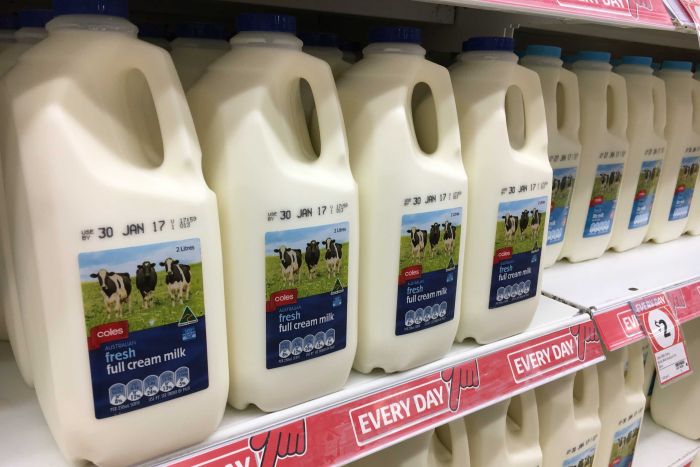
Dairy sales remain a “powerhouse” in retail grocery stores as the coronavirus impact moves into a third month, according to weekly updates from the International Dairy Deli Bakery Association (IDDBA), a nonprofit membership organization serving the dairy, deli, bakery, cheese and supermarket food service industries. While the increase in retail sales can’t fully cover the lost sales in food service, they are helping boost total sales.
In the most recent IDDBA report, which covers weekly sales between March 1-May 3, dairy sales gains have been up double digits over comparable weeks in 2019 for eight weeks running, said Abrielle Backhaus, research coordinator with IDDBA. Year-over-year gains for the week ending May 3 were +28.7% for the overall dairy category, driven by continued strong demand for milk, cheese, butter and creamers. At about 2%, only sales of yogurt fell below the double-digit growth pattern.
Natural cheese had the highest increase in absolute dollars, with year-over-year sales up $91 million, followed by fluid milk, up $47 million.
According to Michael Dykes, president and CEO of the International Dairy Foods Association (IDFA), the strong retail sales is a sign the dairy industry may have “turned the corner and is moving toward brighter days.”
“When the sudden loss of the food service sector flipped our industry upside down, we anticipated that loss could leave as much as 10% of the normal U.S. milk supply without a home,” Dykes said. “Data from March through early May show that figure could be closer to 5% – and possibly lower – thanks in large part to significant dairy purchases by the USDA as well as a rapid response to demand destruction by our dairy cooperatives. The significant government purchases – to the tune of $125 million per month through existing Section 32 programs, entitlement programs [feeding programs], and a new effort called the Farmers to Families Food Box program,and just under $5 billion in available government payments for dairy – have begun to lift the dairy economy.”
Dykes said total store dollar growth for dairy products is up an average of 30% across all categories since March over the same period from last year, according to the most recent IRI and Nielsen data. All categories are above their year-over-year figures, and retail cheese demand is trending close to +35%, retail butter close to +45% and ice cream near +25%.
Food service sales are also bouncing back in May, sooner than expected.
USDA makes it easier to donate dairy
The USDA is making it easier to donate dairy products through the Milk Donation Reimbursement Program (MDRP).
Late last week, USDA undersecretary for marketing and regulatory programs, Greg Ibach, announced the agency will waive certain documentation requirements, allowing U.S. dairy processors to donate more milk for distribution to low-income individuals.
The USDA is also highlighting allowances in the “commodity specifications” for fluid milk processors, providing for flexibility regarding the shelf life of donated milk, if permitted by their state.
The USDA also extended the application period for MDRP donations for fiscal years 2019 and 2020 through Oct. 30, 2020. Once an application is approved, participants will be able to file their reimbursement claims for fiscal year 2019 and 2020 donations until Dec. 31, 2020.
Established under the 2018 Farm Bill, the MDRP allows dairy organizations to partner with nonprofit organizations to distribute food to low-income individuals. Those partnerships may apply for and receive limited reimbursements to cover expenses related to eligible fluid milk product donations. Congress authorized $9 million for the program in fiscal year 2019 and $5 million per fiscal year thereafter.
In February, the USDA approved 133 dairy organization and/or non-profit organization partnerships participating in the program.
USDA buys dairy products
The USDA’s Agricultural Marketing Service (AMS) awarded multiple bids for the delivery of cheese and butter for distribution through domestic feeding programs. The purchases were made under the USDA’s Trade Mitigation Program and other programs, with deliveries scheduled between July and September 2020. Contracts covered:
2.05 million pounds of salted butter in 1-pound packages in prices ranging between about $1.57-$1.79 per pound – winning bids came from Challenge Dairy Products, Dublin, California, and Prairie Farms Dairy, Carlinville, Illinois.
1.739 million pounds of chunk cheddar cheese in 1-pound packages in prices ranging from about $2.12-2.31 per pound and 1.747 million pounds of shredded cheddar cheese in 2-pound packages in prices ranging from about $1.91-$2.06 per pound – winning bids came from Masters Gallery Foods, Plymouth, Wisconsin; Schreiber Foods Inc., Green Bay, Wisconsin; Winona Foods Inc., Green Bay, Wisconsin; Associated Milk Producers Inc., New Ulm, Minnesota; and Dairy Farmers of America, Kansas City, Kansas.
982,800 pounds of mozzarella string cheese in prices ranging from $1.99-$2.25 per pound – winning bids came from Baker Cheese Factory, Saint Cloud, Wisconsin, and Upstate Niagara Co-op, Buffalo, New York.
U.S., global dairy groups concerned about a new round of EU intervention stocks
U.S. and other global dairy organizations expressed concerns over government-financed intervention purchases of skim milk powder (SMP) and butter by the European Union (EU). Dairy farmer and processor groups in key dairy-producing countries around the world called on the EU to avoid what they said were market-distorting practices that have significantly harmed global dairy markets in the past.
The coalition of dairy organizations representing Argentina, Brazil, Chile, Costa Rica, Ecuador, Guatemala, Mexico, Paraguay, Uruguay and the U.S. joined together in urging the EU not to repeat government stockpiling of dairy products.
U.S. groups signing on to a joint statement included the International Dairy Foods Association, National Milk Producers Federation and the U.S. Dairy Export Council.
They warned that exporting large quantities of government-purchased SMP and butter at below-market rates will prolong the deeply challenging environment under which dairy sectors are operating due to the COVID-19 pandemic. The groups instead urged the EU to adopt measures that further spur consumption within the EU and encourage its producers to implement appropriate production practices to survive during this difficult time.
“It’s critical that the EU act now to put a long-term plan into place regarding how to handle its government-incentivized stockpiling given that the EU has a demonstrated history of dumping intervention purchases in a way that disrupts the world dairy market,” the coalition said in a joint statement. “The EU intervened in 2016-17 and held the equivalent of 16% of the global SMP market in government storage. It subsequently released the product on the world market over the next two years, unfairly undercutting international prices and harming the global dairy industry.”
Previously, the lifting of milk production quotas in the EU combined with a dairy import embargo implemented by Russia resulted in the government purchase of extremely large volumes of skim milk powder in 2016-17 in an attempt to support EU milk prices. That inventory overhung the global dairy market and suppressed world dairy prices.
‘Spot’ market cattle bill introduced
U.S. Sens. Chuck Grassley (R-Iowa) and Jon Tester (D-Montana) introduced a bill to require large U.S. meat processing companies to purchase 50% of their weekly volume of beef slaughter on the open or “spot” market. The proposal regulates facilities that slaughters over 125,000 head of cattle annually.
According to proponents, the bill is designed to foster efficient markets while increasing competition and transparency among meat packers who purchase livestock directly from independent producers.
“The lack of transparency in cattle pricing isn’t a new problem, but the negative effects of the fire in Holcomb, Kansas, and COVID-19 have highlighted the need for additional price transparency measures to ensure producers are getting a fair price for the hard work of raising cattle,” said Grassley, who introduced a similar bill nearly two decades ago in 2002.
“Market consolidation in the livestock industry is making it harder and harder for producers to meet their bottom lines, especially as large packers rely on fewer spot transactions to purchase live cattle at the farm gate,” Tester said. “This bill will force meat packers to engage in more spot transactions, bringing up formula prices and making them more accurate while giving Montana producers and feeders more flexibility and transparency when they bring their livestock to market.”
Others supporting the bill were Sens. Tina Smith (D-Minnesota), Joni Ernst (R-Iowa), Mike Rounds (R-South Dakota), Cindy Hyde-Smith (R-Mississippi) and Steve Daines (R-Montana).
Pennsylvania CDE ‘Protecting Your Profits’ webinar scheduled
Matt Lange, business consultant with Compeer Financial, will be featured during the next Pennsylvania Center for Dairy Excellence (CDE) “Protecting Your Profits” webinar, May 27.
Lange will discuss importance of benchmarking and describe how it can help in extreme situations and will summarize strategies to safely reduce milk production to meet mandates by milk marketers and co-ops.
Zach Myers, CDE risk education manager, will lead the conference call and webinar, which begins at noon (Eastern time).
The webinar will be recorded and posted on the CDE website for those who are unable to join the live session. Email Myers for more information.
April global dairy price index falls
Increasing product export availability and weaker demand pushed the global index of dairy prices lower in April, according to the latest United Nations’ Food and Agriculture Organization (FAO) Food Price Index.
The FAO Dairy Price Index includes global average prices for butter, cheese, skim milk (SMP) and whole milk powders (WMP). The April 2020 index declined about 4% from March and was 8.8% less than April 2019, with butter and milk powder prices posting double-digit drops amid increased export availabilities, mounting inventories, weak import demand and diminished restaurant sales in the Northern Hemisphere.
The FAO Food Price Index is a measure of the monthly change in international prices of a basket of five food commodities – cereal, vegetable oil, dairy, meat and sugar. April’s Meat Price Index was down 2.7% and the fourth consecutive month of decline.






















